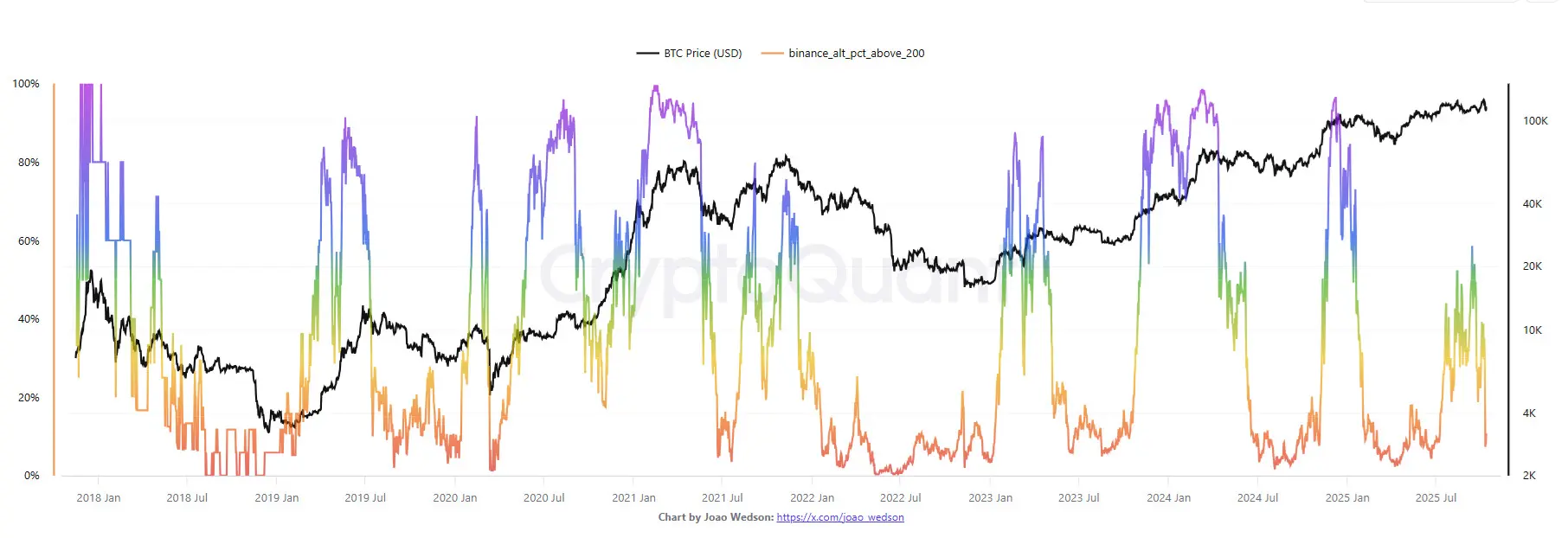altcoins recovery remains uncertain after the October 10–11 liquidations: most altcoins trade below long-term trendlines due to acute liquidity shortfalls and ETF approval delays. Investors should monitor on-chain liquidity, exchange order books and ETF developments for the earliest signs of a sustained rebound.
-
Most altcoins are below long-term trendlines.
-
Liquidity gaps and concentrated market-making amplified October’s liquidations.
-
Altcoin season index fell to 36; only ~10% of tokens retained upward direction (CryptoQuant, on-chain data).
altcoins recovery: After October’s crash most altcoins trade below long-term trendlines. Liquidity shortfalls, ETF delays and on-chain signals shape recovery.
Published: October 14, 2025 | Updated: October 14, 2025 — By COINOTAG
Can altcoins recover after the October 2025 crash?
Altcoins recovery is possible but likely to be gradual. Most altcoins are trading below their 50- and 200-day moving averages following the October 10–11 liquidations, and a sustained rebound will require restored liquidity, renewed retail or institutional demand, and clear progress on ETF approvals.
Market structure matters: assets that relied on concentrated market makers or illiquid exchange books will need time to rebuild order-book depth before price action can sustain higher levels. Historical cycles show altcoins can recover from deep drawdowns, but timing is uncertain.
What drove the October liquidations and how does that affect recovery?
The immediate cause was a liquidity cascade: large sell pressure hit shallow order books on major venues, triggering automatic liquidations and further drawdowns. Exchange-level mechanics—particularly the way some platforms route liquidity and margin positions—intensified the move. Plain-text on-chain and exchange analytics from CryptoQuant and other industry data providers show that roughly 90% of altcoins fell below their long-term trendlines after the event, and the altcoin season index dropped to 36.
Two structural issues will slow recovery: first, many altcoins lack deep, distributed liquidity and depend on a few market-making desks; second, macro and regulatory developments—including delayed ETF approvals amid a U.S. government shutdown—reduced near-term catalysts. For a sustained recovery investors should watch exchange order-book depth, stablecoin flow into exchanges, and ETF approval timelines reported by regulators (SEC) and official filings.
Data points to monitor: percentage of tokens above their 200-day MA, exchange bid/ask spread for top altcoins, stablecoin inflows, and ETF filing status as reported by the SEC and fund issuers (plain text sources).
 90% of altcoins are trading below their long-term trendline after the recent market crash. The indicator has pointed to recoveries in the past, though altcoins can still spend months with depressed prices. | Source: Cryptoquant
90% of altcoins are trading below their long-term trendline after the recent market crash. The indicator has pointed to recoveries in the past, though altcoins can still spend months with depressed prices. | Source: CryptoquantFrequently Asked Questions
How long might altcoins stay below long-term trendlines?
Market recovery timelines vary; historically altcoins have spent several months to over a year below trendlines after major liquidations. With current liquidity constraints and delayed ETF catalysts, the market could remain range-bound until order-book depth and buying interest measurably improve.
What should traders watch to identify a sustainable altcoin rebound?
Listen for rising exchange liquidity and tighter bid/ask spreads, consistent stablecoin inflows, higher percentages of tokens above their 50- and 200-day moving averages, and confirmed ETF approvals or clear regulatory progress. These signals together indicate durable demand rather than short-term bounces.
Are ETFs still a viable catalyst if approvals are delayed?
Yes, ETF approvals remain a potential catalyst, but delayed launches lower near-term expectations. If approvals occur after the shutdown, funds are likely to start at lower price ranges; traders should treat ETF events as stimulants to liquidity rather than guaranteed price accelerants.
Key Takeaways
- Market structure weakness: Most altcoins fell below long-term trendlines due to concentrated liquidity and shallow order books.
- ETF timing matters: Delays to ETF approvals reduce immediate buying pressure; approvals remain a conditional catalyst.
- Data-driven signals: Monitor on-chain liquidity metrics, exchange order books and the percentage of tokens above moving averages to time entries.
Conclusion
Altcoins recovery after the October 10–11 liquidations is feasible but not guaranteed and will be paced by liquidity restoration and regulatory catalysts. Investors should rely on measurable on-chain and exchange indicators—reported by data providers such as CryptoQuant and Glassnode in plain text—and treat ETF developments and order-book improvement as the clearest path to a sustained rebound. COINOTAG will continue monitoring official filings and exchange data and will update coverage as new, verifiable signals emerge.
